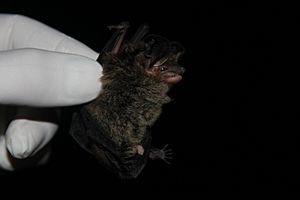Southern big-eared brown bat facts for kids
Quick facts for kids Southern big-eared brown bat |
|
|---|---|
 |
|
| Conservation status | |
| Scientific classification | |
| Genus: |
Histiotus
|
| Species: |
magellanicus
|
 |
|
| Synonyms | |
|
H. capucinus (Philippi, 1866) |
|
The southern big-eared brown bat (scientific name: Histiotus magellanicus) is a type of bat that belongs to the Vespertilionidae family. This bat lives in the forests of southern Argentina and Chile. Even though there aren't many of these bats in the very southern parts of their home, experts don't think they are in serious danger. Because of this, they are listed as "Least Concern" on the IUCN Red List.
About the Southern Big-Eared Bat
This bat is quite small. It measures about 10 to 12 centimetres (3.9 to 4.7 in) long from its head to its tail. Its wings can spread out to about 31 centimetres (12 in) wide. Adult bats usually weigh between 10 to 18 grams (0.35 to 0.63 oz).
The fur of the southern big-eared brown bat is soft and dark brown all over its body. This helps tell it apart from other bats in the same group, which often have lighter, sometimes whitish, fur on their bellies. Its ears are large and a bit long, with a special part called a tragus. Unlike some other bats, its ears are separate on its head, not joined by a strip of skin. The skin on its ears and wings is a very dark brown color.
Where These Bats Live
The southern big-eared brown bat is one of the bats that lives furthest south in the world. It is found only in Chile and the western and southern parts of Argentina. In Chile, it lives as far north as the southern Maule Region. From there, it can be found south through Chile and nearby areas of Argentina, all the way to the Magellan Straits.
Even further south, it lives across all of Tierra del Fuego, almost reaching Cape Horn. These bats mostly live in forests, especially those with southern beech trees. However, they have also been seen in Matorral shrubland and in the high, dry areas of the Andes mountains called steppe country.
Life and Habits of the Bat
Bats in the Histiotus group, including the southern big-eared brown bat, have the largest hearts compared to their body size of any mammal studied. Their hearts make up about 2.18% of their total body weight. This means their hearts are about 63% bigger than what you might expect for an animal their size!
These bats use echolocation to find their way around and hunt. Their echolocation calls are medium-loud signals that last about 10 milliseconds. The sound sweeps down from 40 to 30 kilohertz (kHz).
Breeding for these bats happens during the summer months. Female bats that were feeding their young have been seen in November and December.
Not much is known about how these bats behave. However, we do know that they sometimes use natural holes in dead trees or large living trees as places to rest during the day. Because they rely on trees for roosting, there's a concern that beavers, which were recently brought to Tierra del Fuego, could cause problems for these bats in the future by changing the forests.
See also
 In Spanish: Histiotus magellanicus para niños
In Spanish: Histiotus magellanicus para niños



